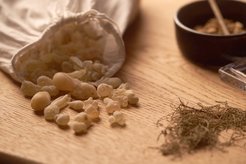Globalizing Scents and Spices: Tracking the trade of aromatics through biomolecular archaeology

Long-distance trade of commodities played a major role in forming political structures and transferring socio-cultural practices among the major centres of ancient civilization in the Old World. Some of the most high-value products that moved along ancient trade routes, were not substantive, calorie-laden foods, but resins, powders, extracts, and obscure dried plant components that nonetheless packed substantial flavour and aroma. Not only did these substances possess the ability to transform cuisines and to scent people and spaces, they also often played significant roles in economic, cultural, medicinal and ritual contexts.
This project aims to investigate the global dimensions of the dispersal of these so-called spices throughout Asia and East Africa. This includes not only the spread of goods, but also the transfer of socio-cultural practices associated with their use. To trace these often “invisible” substances in the archaeological record, Barbara seeks to study organic remains of them by using biochemical and biomolecular approaches. These draw on chromatography, mass spectrometry, and bioinformatics to recover and analyze rare molecules (secondary metabolites, lipids and proteins) preserved within ancient ‘scent archives’. These archives can be archaeological artefacts, such as incense burners, perfume flasks, cooking pots or storage vessels found at different sites along ancient trade routes. Other features such as dental calculus on teeth, mummified remains, or floor surfaces can also function as archives. The most important property of such scent archives is that they contain the remains of aromatic substances used in the past that can be sampled, analysed and identified. Through this approach, the individual aromatics can be pinpointed at places of origin, at the different stops of the trade routes and at destinations, allowing not only to reconstruct ancient trade, exchange systems distribution ranges of these goods, but also to study past networks and connectivity.











